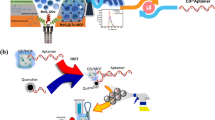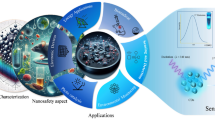Abstract
A method is described for the determination of ascorbic acid (AA) in complex biological fluids. It based on maganese(II)-doped zinc/germanium oxide nanoparticles (Mn@ZnGe NPs) with appealing time-resolved phosphorescence (TRP). TRP can provide a background-free reporter signal in analytical methods. The absorption of AA overlaps the excitation band of Mn@ZnGe NPs at 254 nm. This reduces the intensity of fluorescence via an inner filter effect (IFE) with increasing concentration of AA. Typical experimental conditions include an emission peak at 536 nm, a delay time of 50 μs and a counting time of 2 ms. This method can detect AA in a range of 5–500 μM with a 0.13 μM limit of detection. If AA is oxidized by the enzyme AA oxidase (AAOx), dehydroascorbic acid will be formed which doesn’t absorb at 254 nm. Hence, the IFE cannot occur and fluorescence is not reduced. The strategy can be used to quantify AAOx in the activity range of 1–4 U·mL−1. By using a handheld UV lamp and a smart phone with a color-scanning feature, the feasibility for visual detection and real-time/onsite quantitative scanometric monitoring of AA and AAOx is demonstrated.

Schematic presentation of a fluorometric method for determination of ascorbic acid (AA) and ascorbic oxidase and a scanometric visual assay. It based on the use of maganese(II)-doped zinc/germanium oxide nanoparticles (Mn@ZnGe NPs) with appealing time-resolved phosphorescence (TRP) and the inner-filter effect (IFE) between AA and Mn@ZnGe NPs.






Similar content being viewed by others
References
Zhang L, Tian Y (2018) Designing recognition molecules and tailoring functional surfaces for in vivo monitoring of small molecules in the brain. Acc Chem Res 51:688–696
Niu LY, Chen YZ, Zheng HR, Wu LZ, Tung CH, Yang QZ (2015) Design strategies of fluorescent probes for selective detection among biothiols. Chem Soc Rev 44:6143–6160
Luo Y, Zhang L, Liu W, Yu Y, Tian Y (2015) A single biosensor for evaluating the levels of copper ion and L-cysteine in a live rat brain with Alzheimer’s disease. Angew Chem Int Ed 54:14053–14056
Wu F, Yu P, Mao L (2017) Self-powered electrochemical systems as neurochemical sensors: toward self-triggered in vivo analysis of brain chemistry. Chem Soc Rev 46:2692–2704
Ma S, Qi YX, Jiang XQ, Chen JQ, Zhou QY, Shi G, Zhang M (2016) Selective and sensitive monitoring of cerebral antioxidants based on the dye-labeled DNA/Polydopamine conjugates. Anal Chem 88:11647–11653
Han XY, Chen ZH, Zeng JZ, Fan QX, Fang ZQ, Shi G, Zhang M (2018) Inorganic−organic hybrid tongue-mimic for time-resolved fluorescent noninvasive pattern and chiral recognition of thiols in biofluids toward healthcare monitoring. ACS Appl Mater Interfaces 10:31725–31734
Rice ME (2000) Ascorbate regulation and its neuroprotective role in the brain. Trends Neurosci 23:209–216
Shenoy N, Creagan E, Witzig T, Levine M (2018) Ascorbic acid in Cancer treatment: let the Phoenix Fly. Cancer Cell 34:700–706
Agathocleous M, Meacham CE, Burgess RJ, Piskounova E, Zhao Z, Crane GM, Cowin BL, Bruner E, Murphy MM, Chen W, Spangrude GJ, Hu Z, Deberardinis RJ, Morrison SJ (2017) Ascorbate regulates haematopoietic stem cell function and leukaemogenesis. Nature 549:476–481
Hei Y, Li X, Zhou X, Liu J, Hassan M, Zhang S, Yang Y, Bo X, Wang HL, Zhou M (2018) Cost-effective synthesis of three-dimensional nitrogen-doped nanostructured carbons with hierarchical architectures from the biomass of sea-tangle for the amperometric determination of ascorbic acid. Anal Chim Acta 1029:15–23
Zou HL, Li BL, Luo HQ, Li NB (2017) 0D-2D heterostructures of au nanoparticles and layered MoS2 for simultaneous detections of dopamine, ascorbic acid, uric acid, and nitrite. Sensor Actuat B-Chem 253:352–360
Zou HL, Li BL, Luo HQ, Li NB (2015) A novel electrochemical biosensor based on hemin functionalized graphene oxide sheets for simultaneous determination of ascorbic acid, dopamine and uric acid. Sensor Actuat B-Chem 207:535–541
Xu C, Hei Y, Liu J, Sun M, Sha T, Wang N, Hassan M, Bo X, Zhou M (2018) Synthesis of a three-dimensional interconnected carbon nanorod aerogel from wax gourd for amperometric sensing. Microchim Acta 185:482–493
Meng HM, Zhang XB, Yang C, Kuai H, Mao GJ, Gong L, Zhang W, Feng S, Chang J (2016) Efficient two-photon fluorescence Nanoprobe for turn-on detection and imaging of ascorbic acid in living cells and tissues. Anal Chem 88:6057–6063
Niu WJ, Shan D, Zhu RH, Deng SY, Cosnier S, Zhang XJ (2016) Dumbbell-shaped carbon quantum dots/AuNCs nanohybrid as an efficient ratiometric fluorescent probe for sensing cadmium (II) ions and L-ascorbic acid. Carbon 96:1034–1042
Feng LL, Wu YX, Zhang DL, Hu XX, Zhang J, Wang P, Song ZL, Zhang XB, Tan W (2017) Near infrared graphene quantum dots-based two-photon Nanoprobe for direct bioimaging of endogenous ascorbic acid in living cells. Anal Chem 89:4077–4084
Zheng M, Xie Z, Qu D, Li D, Du P, Jing X, Sun Z (2013) On−off−on fluorescent carbon dot Nanosensor for recognition of chromium (VI) and ascorbic acid based on the inner filter effect. ACS Appl Mater Interfaces 5:13242–13247
Devi JSA, Salini S, Anulekshmi AH, Praveen GL, Sony G (2017) Fe (III) ion modulated l-DOPA protected gold nanocluster probe for fluorescence turn on sensing of ascorbic acid. Sensor Actuat B-Chem 246:943–951
Wang J, Peng X, Li D, Jiang X, Pan Z, Chen A, Huang L, Hu J (2018) Ratiometric ultrasensitive fluorometric detection of ascorbic acid using a dually emitting CdSe@SiO2@CdTe quantum dot hybrid. Microchim Acta 185:42
Rong M, Lin L, Song X, Wang Y, Zhong Y, Yan J, Feng Y, Zeng X, Chen X (2015) Fluorescence sensing of chromium (VI) and ascorbic acid using graphitic carbon nitride nanosheets as a fluorescent “switch”. Biosens Bioelectron 68:210–217
Yu J, Yang W, Xing S, Wang J, Han H, Zhang P, Xiang C, Zhang B (2019) Blended gold/MnO2@BSA nanoparticles for fluorometric and magnetic resonance determination of ascorbic acid. Microchim Acta 186:89
Achadu OJ, Revaprasadu N (2019) Tannic acid-derivatized graphitic carbon nitride quantum dots as an “on-off-on” fluorescent nanoprobe for ascorbic acid via copper(II) mediation. Microchim Acta 186:87
Zhou R, Li Y, Tian Y, Sun Q, Deng P, Wu L, Hou X (2017) Simple fluorescence sensing of extreme acidity based on inner filter effect of ascorbic acid to fluorescent au nanoclusters. Nanoscale 9:10167–10172
Zannoni V, Lynch M, Goldstein S, Sato P (1974) A rapid micromethod for the determination of ascorbic acid in plasma and tissues. Biochem Med 11:41–48
Woo BK, Luo Z, Li Y, Singh SP, Joly AG, Hossu M, Liu Z, Chen W (2011) Luminescence enhancement of CaZnGe2O6:Tb3+ afterglow phosphors synthesized using ZnO nanopowders. Opt Mater 33:1283–1290
Wan M, Wang Y, Wang X, Zhao H, Hu Z (2014) The properties of a novel green long afterglow phosphor Zn2GeO4:Mn2+, Pr3+. Opt Mater 36:650–654
Yue D, Huang Y, Zhang J, Zhang X, Cui YJ, Yang Y, Qian GD (2017) A two-dimensional metal-organic framework as a fluorescent probe for ascorbic acid sensing. Eur J Inorg Chem 2018:173–177
Park HW, Alam SM, Lee SH, Karim MM, Wabaidur SM, Kang M, Choi JH (2009) Optical ascorbic acid sensor based on the fluorescence quenching of silver nanoparticles. Luminescence 24:367–371
Chen S, Yu YL, Wang JH (2018) Inner filter effect-based fluorescent sensing systems: a review. Anal Chim Acta 999:13–26
Messerschmidt A, Rossi A, Ladenstein R, Huber R (1989) X-ray crystal structure of the blue oxidase ascorbate oxidase from zucchini. Analysis of the polypeptide fold and a model of the copper sites and ligands J Mol Bio 206:513–529
Kim K, Jordan KD (1994) Comparison of density functional and MP2 calculations on the water monomer and dimer. J Phys Chem 98:10089–10094
Frisch MJ, Trucks GW, Schlegel HB, Scuseria GE, Robb MA, Cheeseman JR, Scalmani G, Barone V, Mennucci B, Petersson GA, Nakatsuji H, Caricato M, Li X, Hratchian HP, Izmaylov AF, Bloino J, Zheng G, Sonnenberg JL, Hada M, Ehara M, Toyota K, Fukuda R, Hasegawa J, Ishida M, Nakajima T, Honda Y, Kitao O, Nakai H, Vreven T, Montgomery JA, Jr Peralta JE, Ogliaro F, Bearpark M, Heyd JJ, Brothers E, Kudin KN, Staroverov VN, Kobayashi R, Normand J, Raghavachari K, Rendell A, Burant JC, Iyengar SS, Tomasi J, Cossi M, Rega N, Millam NJ, Klene M, Knox JE, Cross JB, Bakken V, Adamo C, Jaramillo J, Gomperts RE, Stratmann O, Yazyev AJ, Austin R, Cammi C, Pomelli JW, Ochterski R, Martin RL, Morokuma K, Zakrzewski VG, Voth GA, Salvador P, Dannenberg JJ, Dapprich S, Daniels AD, Farkas O, Foresman JB, Ortiz JV, Cioslowski J, Fox DJ Gaussian 09, revision A.02; Gaussian, Inc.: Wallingford, CT, 2009
Zhang M, Le HN, Jiang XQ, Yin BC, Ye BC (2013) Time-resolved probes based on guanine/thymine-rich DNA-sensitized fluorescence of terbium (III). Anal Chem 83:11665–11674
Liu XF, Xia YM, Fang Y, Zou L, Liu LL (2004) Interaction between natural pharmacyeutical homologues of coumarin and bovine serum albumin. Acta Chim Sin 62:1484–1490
Li Y, Gao F, Gao F, Shan F, Bian J, Zhao C (2009) Study on the interaction between 3 flavonoid compounds and α-amylase by fluorescence spectroscopy and enzymatic kinetics. J Food Sci 74:199–203
Zhang W, Shi Y, Liu L, Li Y, Wang D, Ma H, Ma H, Chen Z, Jang W, Han Y, Ye BC (2018) Electrochemical sensing platform based on the biomass-derived microporous carbons for simultaneous determination of ascorbic acid, dopamine, and uric acid. Biosens Bioelectron 121:96–103
Li Y, Song H, Zhang L, Zuo P, Ye BC, Yao J, Chen W (2016) Supportless electrochemical sensor based on molecularly imprinted polymer modified nanoporous microrod for determination of dopamine at trace level. Biosens Bioelectron 78:308–314
Liu L, Liu L, Wang Y, Ye BC (2019) A novel electrochemical sensor based on bimetallic metal-organic framework-derived porous carbons for detection of uric acid. Talanta 199:478–484
Du J, Zhu B, Chen X (2013) Urine for Plasmonic nanoparticle-based colorimetric detection of mercury ion. Small 9:4101–4111
Acknowledgments
This work was supported by the National Natural Science Foundation of China (21775044, 21675053, 21635003), Natural Science Foundation of Shanghai (19ZR1473300), Key Project of the Shanghai Science and Technology Committee (18DZ1112700), and Science and Technology Planning Project of Guangdong Province (2016B020238003).
Author information
Authors and Affiliations
Corresponding author
Ethics declarations
The author(s) declare that they have no competing interests.
Additional information
Publisher’s note
Springer Nature remains neutral with regard to jurisdictional claims in published maps and institutional affiliations.
Electronic supplementary material
ESM 1
(DOC 644 kb)
Rights and permissions
About this article
Cite this article
Han, XY., Chen, ZH., Fan, QX. et al. Manganese(II)-doped zinc/germanium oxide nanoparticles as a viable fluorescent probe for visual and time-resolved fluorometric determination of ascorbic acid and its oxidase. Microchim Acta 186, 466 (2019). https://doi.org/10.1007/s00604-019-3580-9
Received:
Accepted:
Published:
DOI: https://doi.org/10.1007/s00604-019-3580-9




